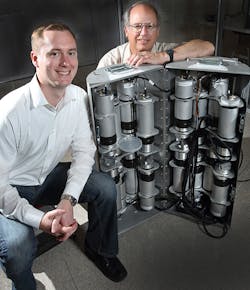Electronic “Sniffer” Searches Out Nuclear Devices
The nightmare scenario for the Dept. of Homeland Security is a briefcase-sized nuclear weapon on the loose in a major U.S. city. To counter this potential threat, engineers at Sandia National Laboratory have built a mobile imager of neutrons for emergency responders (MINER). It is a portable neutron scatter camera that detects fast neutrons emanating from nuclear materials. It should let police forces pinpoint the source of the neutrons at significant distances and despite shielding.
MINER’s design is based on that of a larger scatter camera that stands 5 ft tall and requires a special power source. In contrast, MINER is about 3 ft tall and weighs 90 lb. Inside, 16 proton-rich liquid scintillator detector cells circle a large cylinder. Neutrons travel through the cells, bouncing off protons like ping pong balls. These interactions among the detector cells let the device calculate what direction those neutrons came from. Compared to other detectors, this technology lets MINER pick out the target radiation from background radiation and can measure the spectrum of neutrons being emitted. This lets it tell the difference between neutrons from plutonium, a threat, and americium-beryllium, a common commercial source of neutrons and not a threat. MINER also searches a 360° horizon. Other detectors have a narrow field of view and must be pointing in the source’s direction to pick it up.
MINER can be set up and operating in 10 minutes and uses battery power, which makes it more portable.
In a field test set in downtown Chicago recently, MINER found a sealed radiation source in 30 minutes. In fact, the device could scan an entire side of a skyscraper at one time, quickly narrowing the search down to a single room. When the source was shielded, the search took a few hours.

